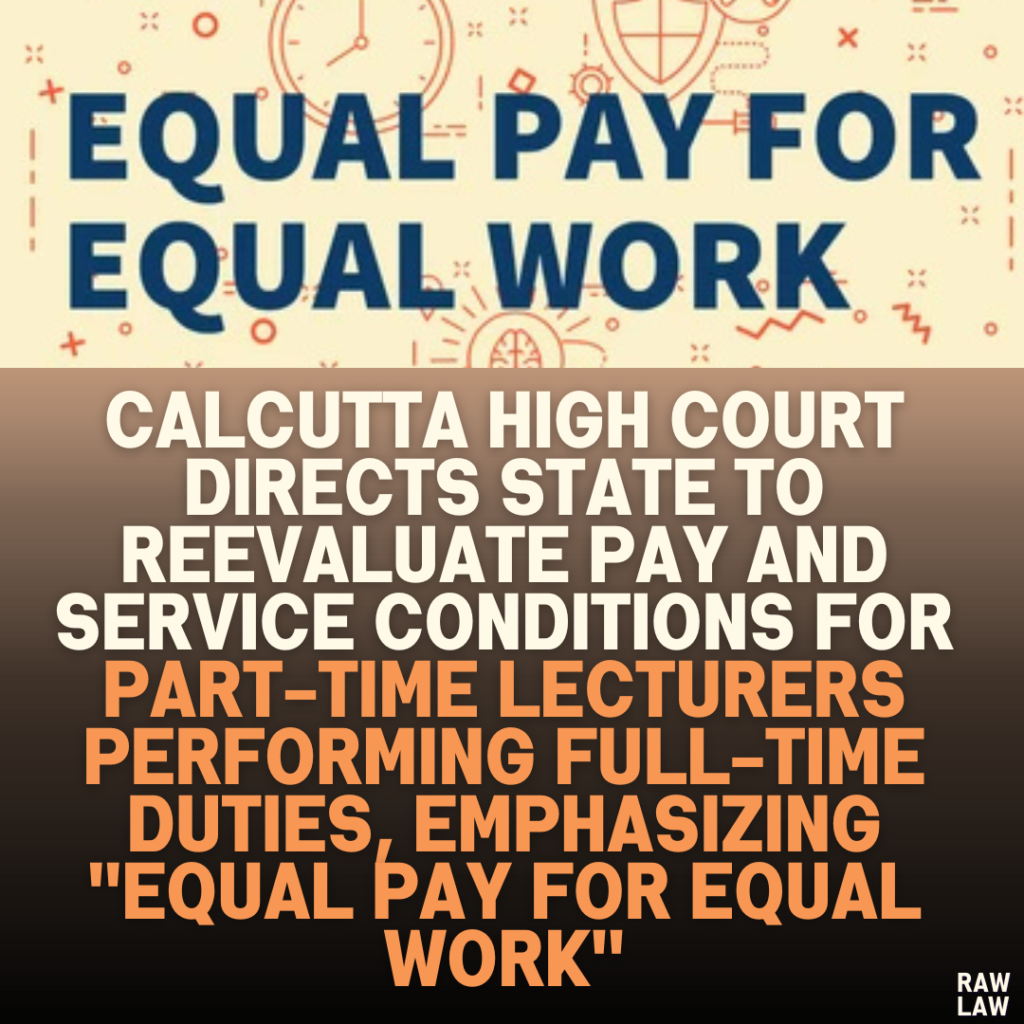Court’s Decision:
The High Court of Calcutta acknowledged that the petitioners, engaged as part-time contractual lecturers, were performing duties equivalent to full-time lecturers. It directed the respondent authorities to reevaluate their pay structure and terms of service based on the 2010 notification but clarified that the petitioners were not entitled to benefits under the Finance Department Memo No. 9008-F(P) (2011). The court emphasized that “the Government, being a benevolent State, must provide proper remuneration and other terms and conditions of service of petitioners apropos to their job responsibilities.”
Facts:
- Employment History:
- The petitioners were engaged as part-time lecturers in various government polytechnic colleges in West Bengal.
- Initially, their engagement was on a per-class basis, with remuneration determined hourly.
- Key Notifications:
- Notification No. 557 (2010): Changed the status of part-time lecturers to contractual employees, fixing their monthly remuneration for a minimum of 15 classes per week.
- GO No. 765 (2011): Clarified that part-time lecturers engaged before July 2010 would continue to receive fixed monthly remuneration.
- Claim of Benefits:
- Petitioners claimed entitlement under Memo No. 9008-F(P) (2011), which granted benefits such as job security and enhanced pay to contractual workers with over ten years of continuous service.
- Responsibilities:
- Petitioners performed duties exceeding those of part-time lecturers, including administrative tasks, examination duties, and teaching hours comparable to full-time staff.
Issues:
- Eligibility for Memo No. 9008-F(P) (2011):
- Can the petitioners, as part-time contractual lecturers, claim benefits meant for full-time contractual employees?
- Application of “Equal Pay for Equal Work”:
- Should the petitioners receive pay and service conditions comparable to full-time lecturers based on their duties and responsibilities?
Petitioner’s Arguments:
- Eligibility Under the Memo:
- The petitioners argued they met the criteria under Memo No. 9008-F(P) (2011), having served over ten years with more than 240 days of service annually.
- Parity with Full-Time Lecturers:
- They highlighted that their teaching hours, duties, and responsibilities were equivalent to those of full-time lecturers, warranting equal pay.
- Cited State of Punjab v. Jagjit Singh (2007) and Subhasankar Dubey v. Divisional Forest Officer (2019), asserting that employees performing similar roles should receive comparable remuneration.
Respondent’s Arguments:
- Nature of Employment:
- The State argued that the petitioners were part-time contractual lecturers, not engaged against sanctioned posts, and thus ineligible for benefits under the memo.
- Distinction from Full-Time Lecturers:
- The State contended that the petitioners’ roles were limited and did not warrant parity with full-time lecturers, who were recruited through a formal process.
Analysis of the Law:
- Principle of Equal Pay:
- Referring to Jagjit Singh v. State of Punjab and related precedents, the court reiterated that “an employee engaged for the same work cannot be paid less than another who performs the same duties and responsibilities.”
- Applicability of Memo No. 9008-F(P):
- The memo specifically addressed full-time contractual workers. The court noted that part-time lecturers were not covered under its scope.
Precedent Analysis:
- Jagjit Singh v. State of Punjab (2007):
- Established that disparity in pay for workers performing similar duties was unconstitutional in a welfare state.
- Subhasankar Dubey v. Divisional Forest Officer (2019):
- Reiterated the principles of fairness and non-discrimination in compensation.
Court’s Reasoning:
- Exclusion from Memo Benefits:
- The court concluded that Memo No. 9008-F(P) (2011) was intended for full-time contractual employees and did not apply to part-time lecturers.
- Government’s Responsibility:
- Observing the petitioners’ extensive workload, the court emphasized that the government must revise their pay and service conditions to reflect their contributions.
- Human Dignity and Fair Treatment:
- The court invoked the principle of “equal pay for equal work,” highlighting the moral and legal obligation of the state to ensure fair remuneration.
Conclusion:
- The court directed the respondents to:
- Reevaluate the petitioners’ pay structure and terms of service under Notification No. 557 (2010).
- Take a reasoned decision within eight weeks of receiving a representation from the petitioners.
- Liberty was granted to the petitioners to submit a representation within four weeks.
- The respondent authorities were instructed to act promptly and communicate their decision within two weeks thereafter.
Implications:
- The judgment reinforces the principle of “equal pay for equal work” and highlights the judiciary’s role in addressing disparities in contractual employment.
- It sets a precedent for fair treatment of part-time lecturers and similar categories of workers in government institutions.



